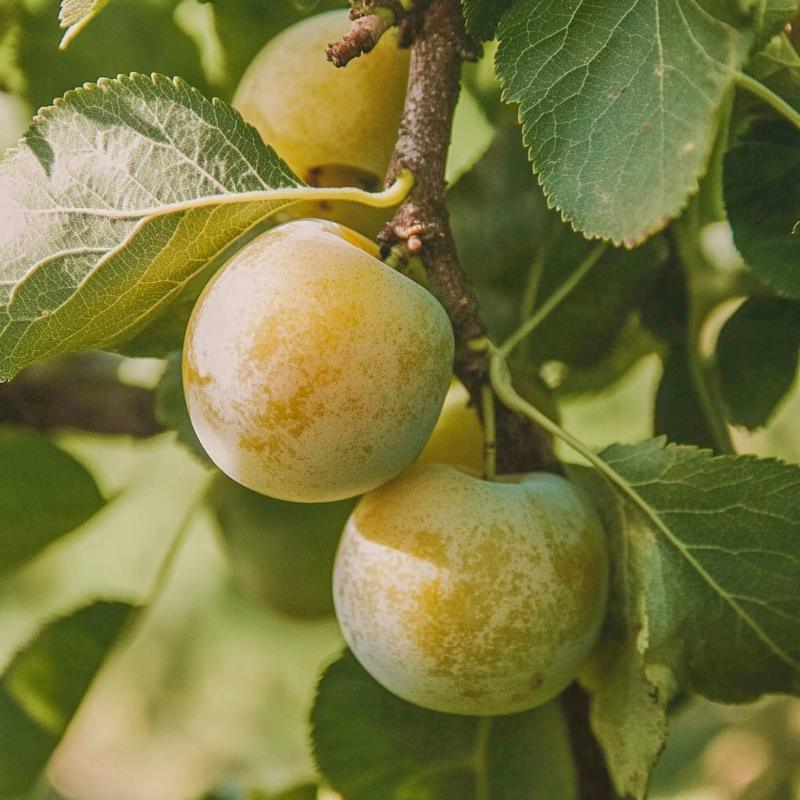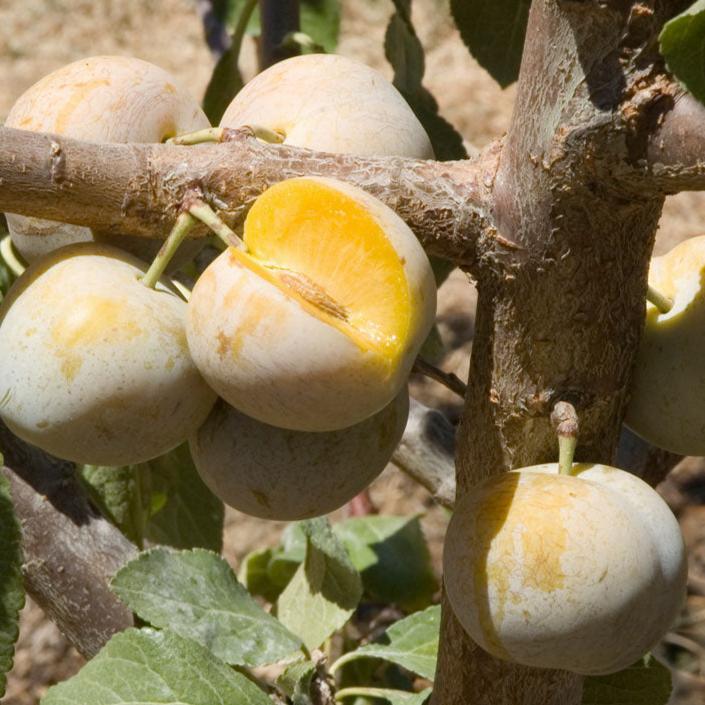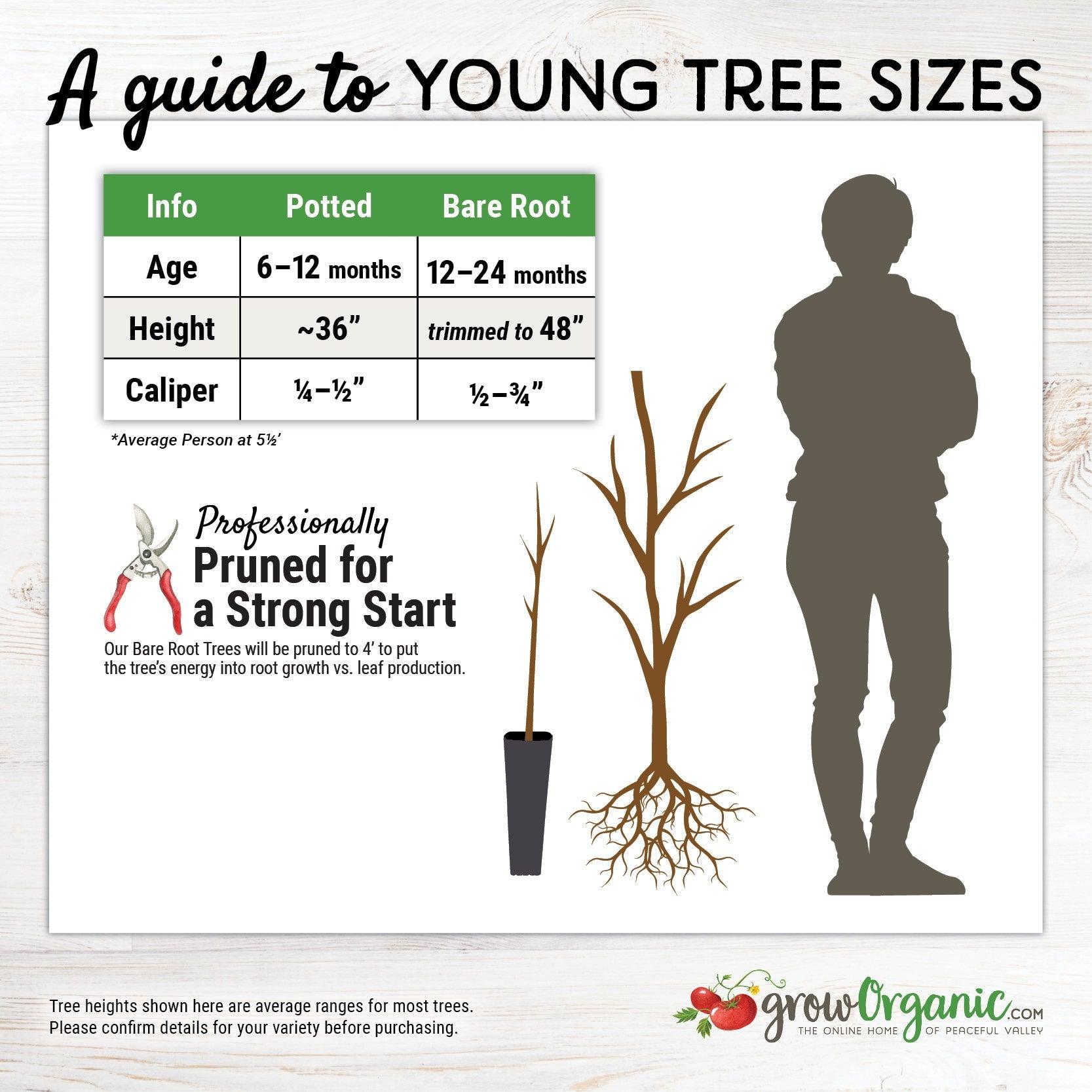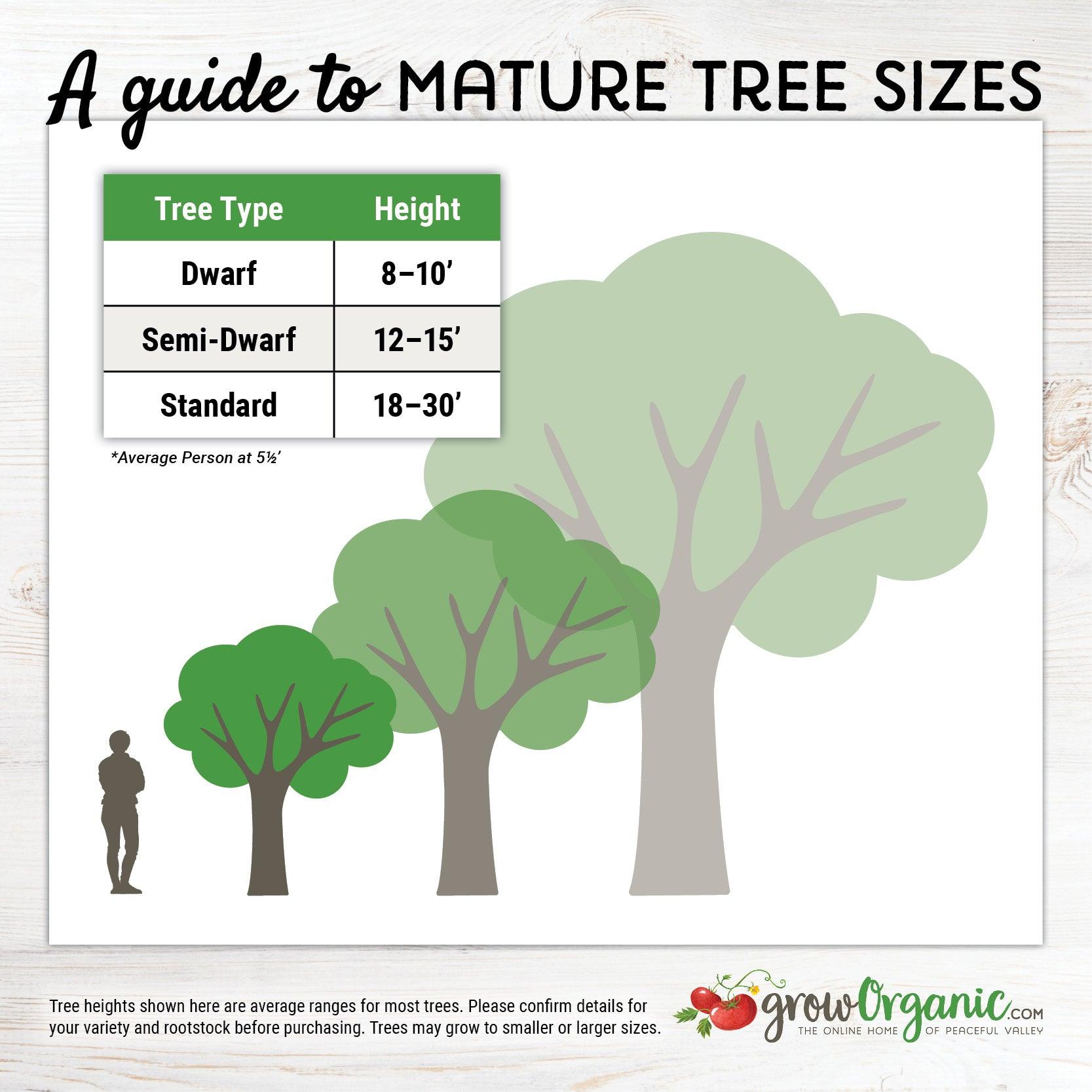Item Number: FT203
Green Gage Plum Tree
Sweet plums with heritage flavor.
Bavay's Green Gage is a cherished heirloom plum variety, renowned for its exquisite honey-like sweetness. Often hailed as the finest-flavored of all European plums, it remains a favorite among fruit enthusiasts. Known for their small, round fruit with smooth green skin and tender, golden flesh. These plums are exceptionally sweet and flavorful, making them perfect for fresh eating, preserves, and baking. Thriving in full sun and well-draining soil, Green Gage trees require moderate chill hours and benefit from a pollinator, such as Italian Plum, French Improved Prune and Blue Damson Plum, for enhanced yields. The tree blooms in early spring with delicate white flowers, adding ornamental value. With its rich heritage, unparalleled sweetness, and versatility, Green Gage is a timeless choice for plum enthusiasts.
Semi-Dwarf on Citation rootstock.
Green Gage Plum trees, scientifically known as Prunus domestica 'Green Gage,' are prized for their sweet and flavorful fruits, which have been cultivated for centuries. These trees are relatively easy to grow and can provide a bountiful harvest for home gardeners and orchard enthusiasts alike. Here's a comprehensive guide on how to grow and care for Green Gage Plum trees:
-
Zones: 5-9
-
Chill hours: 700
-
Harvest: July-August
-
Looks: Small-medium sized with attractive bright green skin and amber, smooth-textured flesh.
-
Personality: Tart-sweet with rich candy-like flavor; excellent fresh, dried and cooked.
-
Facts of note: Green Gage–Bavay's, is an heirloom plum variety prized for its exceptional honey taste. Considered by many to be the finest flavored of all European Plums. Small green fruit with translucent greenish-yellow flesh develop red blush when ripe. Adapted to a wide range of climates the Green Gage tolerates the cold and unpredictable winters and springs of zone 5 and 6 as well as ripening in the warmth of zone 9. This variety can take a few more years then most to begin to set. But dependable year after year after the first good crop. Though self-fruitful the Green Gage will set a larger crop when planted with other European plum varieties.
-
Pollination: Self-fruitful, but the fruit crop will be larger if the tree is planted with a second tree.
-
Planting: Green Gage Plum trees thrive in well-drained soil with a pH level between 6.0 and 7.0. Choose a sunny location with at least 6 to 8 hours of sunlight daily. Plant your tree in early spring or late fall when the soil is workable. Ensure the planting hole is twice as wide as the root ball and slightly shallower.
-
Spacing: Allow sufficient spacing between trees, approximately 15 to 20 feet apart, to ensure proper air circulation and sunlight penetration. This spacing helps prevent diseases and ensures healthy growth and fruit production.
-
Watering: Newly planted Green Gage Plum trees require regular watering to establish their root systems. Provide 1 to 1.5 inches of water per week, either through rainfall or manual irrigation, during the growing season. Once established, these trees are moderately drought-tolerant but benefit from consistent moisture during fruit development.
-
Fertilization: Apply a balanced fertilizer, such as 10-10-10, in early spring before new growth begins. Follow the manufacturer's instructions regarding application rates and methods. Avoid excessive nitrogen fertilization, as it can promote vegetative growth at the expense of fruit production.
-
Pruning: Prune Green Gage Plum trees during the dormant season, typically in late winter or early spring, to remove dead, damaged, or diseased branches. Additionally, thin out crowded branches to improve airflow and light penetration. Avoid heavy pruning, as it can stimulate excessive vegetative growth and reduce fruiting.
-
Pest and Disease Management: Keep an eye out for common pests and diseases that may affect Green Gage Plum trees, such as aphids, plum curculio, and brown rot. Monitor your trees regularly and take appropriate measures, such as applying insecticidal soap or horticultural oil, to control pests. Practice good sanitation by removing fallen fruit and debris to minimize disease spread.
-
Harvesting: Green Gage Plum trees typically produce ripe fruit in late summer to early fall, depending on the growing region and climate. Harvest plums when they are fully ripe but still firm to the touch. Ripe fruit will have a slight give when gently squeezed and will detach easily from the tree with a gentle twist.
-
Storage: Store harvested plums in a cool, dry place or refrigerate them to prolong freshness. Avoid washing plums until ready to eat, as excess moisture can promote spoilage. Green Gage Plums are known for their excellent flavor and can be enjoyed fresh, used in baking, or preserved through canning or freezing.
-
Pollination: Green Gage Plum trees are self-fertile but benefit from cross-pollination to improve fruit set and yield. Planting multiple varieties of plum trees nearby can enhance pollination and increase fruit production. Bees and other pollinators play a crucial role in this process, so encourage biodiversity in your garden to attract them.
-
Winter Protection: In regions with harsh winters, provide winter protection for young Green Gage Plum trees to prevent frost damage. Mulch around the base of the tree to insulate the roots and protect them from freezing temperatures. Consider wrapping the trunk with tree wrap or burlap to prevent sunscald and frost cracks.
Overall, growing Green Gage Plum trees can be a rewarding experience for gardeners of all skill levels. With proper care and maintenance, these trees can provide an abundance of delicious fruit for many years to come. Whether enjoyed fresh, baked into pies, or preserved for later use, Green Gage Plums are sure to delight taste buds and bring joy to the garden.
-
Visit our Fruit Tree Central for a listing of all our fruit tree videos and articles.
- Visit Tree Characteristics for a listing of all our fruit & nut tree growing characteristics.
For more information about different types of rootstocks and how they influence tree size and growth, see our Tree Rootstock Characteristics Chart.


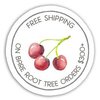
Check Your Zone Compatibility:
Compatible with your zone.
Growing Zone for

Our Guarantee To You
Since 1976, we've served our customers at every stage of growing. Please contact us at any time. We are happy to support and assist you.
Shipping Information
Shipping Information
Cannot ship to the following states: HI, AK, PR, GU, VI
Shipping Weight: 5.0 lb
Dimensions: 47.5"L x 7.3"W x 2.75"H
Features
Features
- Bare Root
- Self-fruitful
- Suited to Cold Climates
Characteristics
Characteristics
Planting & Care
Planting & Care
Useful Information
Useful Information
Guarantee
Guarantee
Limited Dormant Tree & Plant Guarantee
* Claim deadline is June 15th
We guarantee that your dormant tree or plant will arrive in good, viable condition. If your tree arrives in substandard condition, notify us within 3 days of delivery. Please email pictures of the box, inside packaging, the tree and its roots to helpdesk@groworganic.com. We will investigate your claim and process a request to exchange or refund the damaged product.
If your dormant tree or plant has not grown new leaves by June 15th, you may be eligible for our Limited Dormant Tree & Plant Guarantee. This guarantee provides for a store credit for the purchase price of the tree, excluding shipping. Please see the Instructions below.
Important Dates:
- April 1st Dormant trees/plants must be planted in the ground
- May 15th Perform scratch test, if no new leaves have grown
- June 15th Deadline to apply for a dormant tree/plant credit
All required documentation must be received by June 15th for your claim to be considered. Claims or documentation received after June 15th will be denied, without exception. Instructions listed below
Terms and Conditions
We cannot guarantee that your tree or plant will remain alive and healthy after it is received, or bear fruit as there are too many variables in your environment that are beyond our control (i.e. soil preparation, weed and pest control, proper irrigation, chill hours, compatible hardiness for your growing zone, proper choice of pollinator, extreme weather, rodent damage, disease, etc.).
We cannot guarantee that we will be able to provide a replacement tree/plant of the same species either that same growing season or in future years. Customers are responsible for all shipping fees associated with replacement trees and plants.
If we determine that the tree you purchased directly from us is not viable, we will issue you a store credit (not a refund) for the purchase price of the affected dormant tree or plant. Shipping is not included in the dormant tree/plant guarantee. Store credits can be used to purchase any product we sell and are valid for use only until July 1st of the following year.
Historically, 98% of our dormant trees and plants grow and thrive when they have been cared for and planted using our growing guides. Dormant trees and plants must be planted in the ground by April 1st in order to be eligible for credit. If the ground in your area is still frozen solid, you may temporarily plant your tree or plant in a pot.
Potted, non-dormant trees or plants are excluded from this guarantee as they are not dormant at the time of shipment. Evergreen trees such as citrus, avocado and olive trees are not available for credit under the Dormant Tree and Plant Guarantee.
Instructions
We guarantee that your dormant fruit tree or plant will leaf out, if you care for it according to our growing guides. In the unlikely event that your dormant tree or plant does not have leaves by May 15th, follow these simple steps to apply for a store credit:
Before you call or email, please perform a “scratch test” to determine if the tree or plant is still alive. This video shows how to check for live tissue under the bark. Scratch tests need to be done a few inches above and below the graft.
Green Cambium Layer / Living Trees
If the cambium layer under the bark is green, give your tree a little more time. It is still alive, but hasn’t come out of dormancy yet. Check to make sure that it is getting the right amount of deep root water, enough sunlight and that the weather is warm enough for that type of tree/plant to come out of dormancy. Every tree has its own personality and will come out of dormancy at different times. Be sure to submit the required documentation listed below by June 15th, if it doesn’t grow leaves.
Brown Cambium Layer / Dead Trees
If the scratch test shows a brown cambium layer or if your dormant tree/plant doesn’t have leaves by June 1st, please email us at helpdesk@groworganic.com. All required documentation listed below must be received by June 15th for your claim to be considered. To be considered for the guarantee claim, all required documentation must be received by June 15th. Incomplete submissions will be denied.
Required Documentation
- Order number
- Name of dormant tree/plant and the quantity affected
- Photos of each tree or plant showing:
- The roots (tree or plant must be pulled out of the ground)
- The scratch test areas
- The entire tree/plant
We reserve the right to not issue credit for items that have already been replaced. We also reserve the right to require photographic evidence that the tree/plant was not killed by root rot, rodent or mechanical damage.
Share
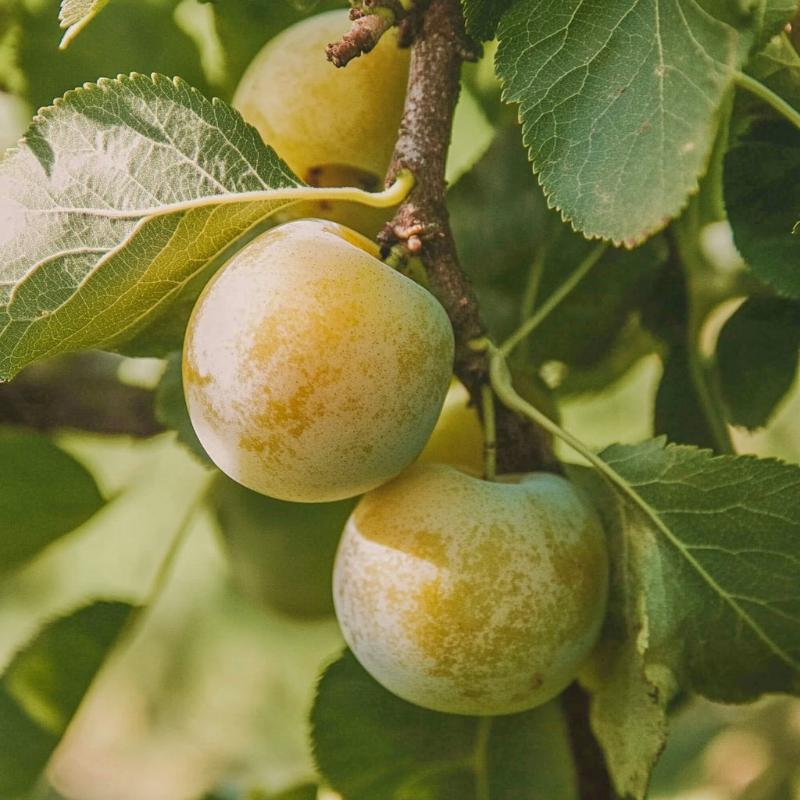
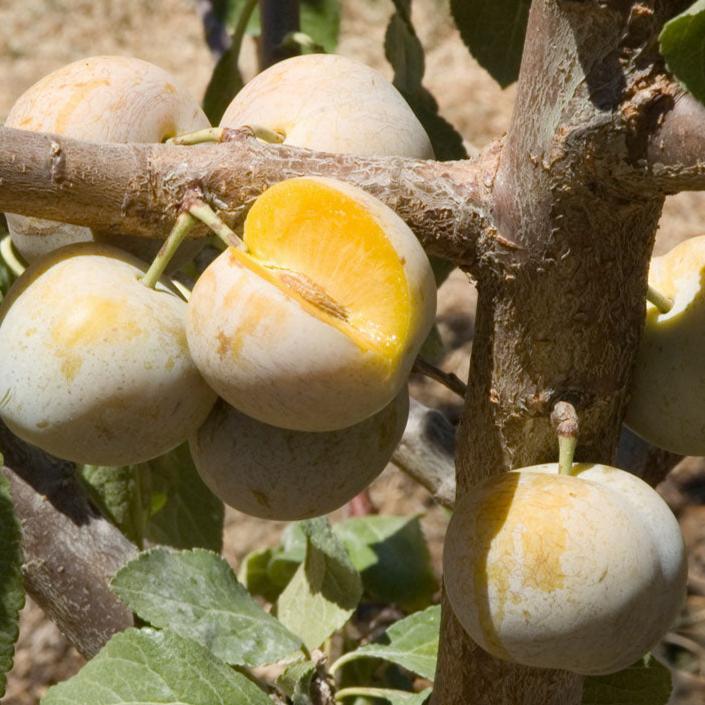
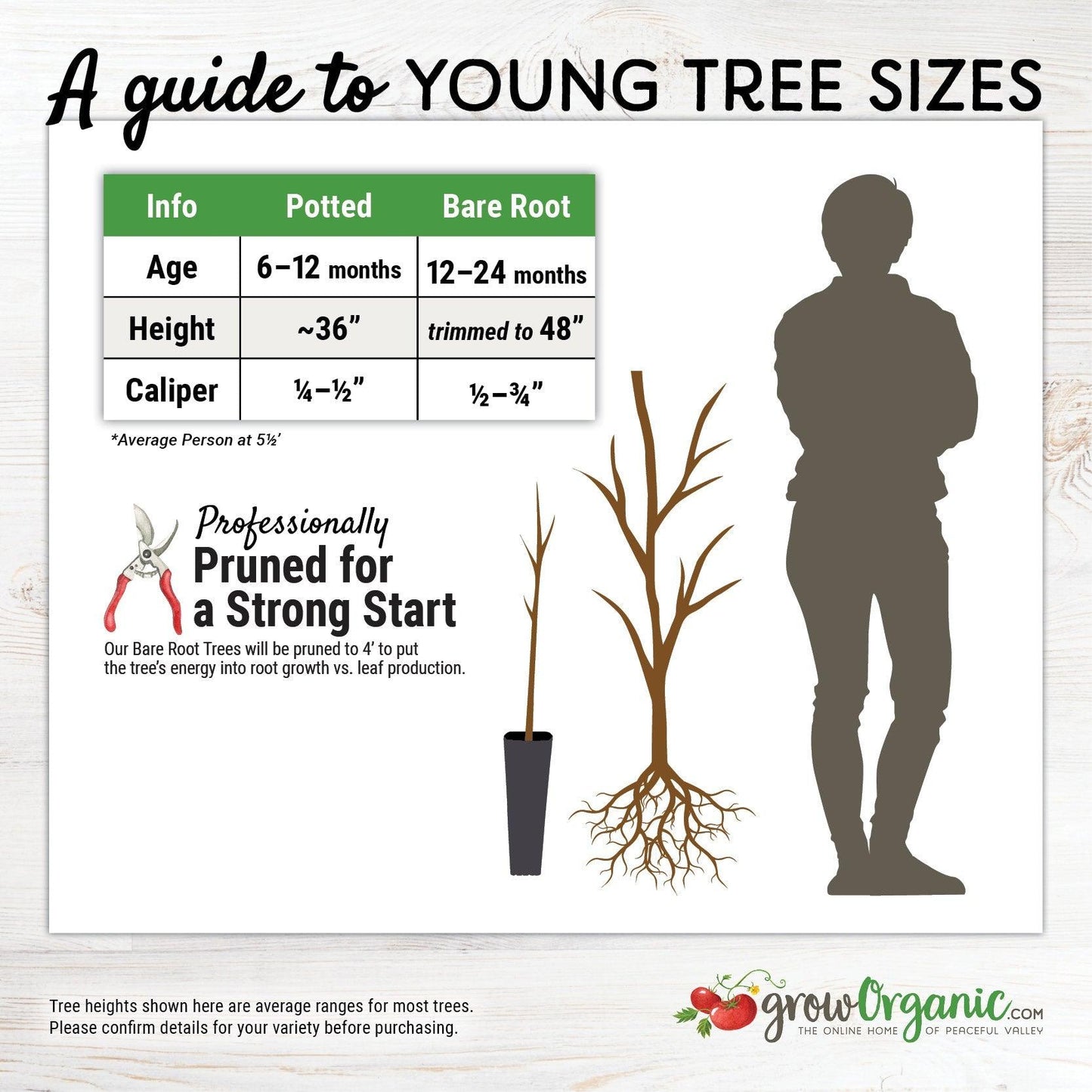
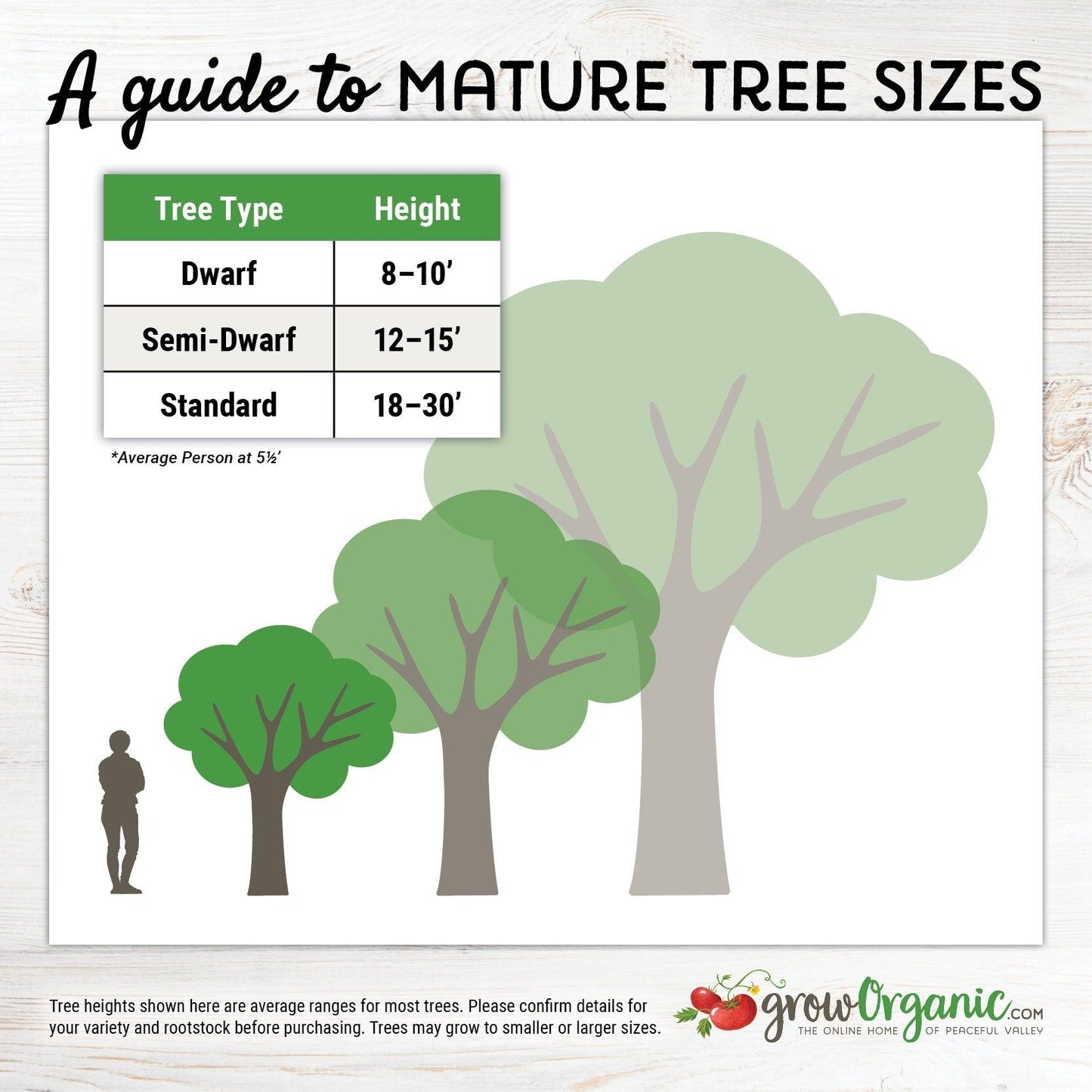
The tree is very healthy, it has a good sized trunk, perfect graft, very happy with the buy. Within weeks of planting, lots of new growth,thank you. I'll definitely recommend grow organic nursery to all.
I have bought fruit trees from just about every online retailer available and I can say with complete confidence that grow organic offers great trees!.. unlike others …everything I’ve received has been true to variety.. heathy.. and has grown very well… keep up the great work and if your on the fence about ordering… don’t worry!… this company has you covered!
I have finally decided! I will only order my plum trees from Grow Organic. I have never received my trees so well packed and healthy. Nice trucks and the leader branches were already cut for me. I am amazed at the first two trees I have received. I have two more trees coming. I have a feeling they will be just as amazing. Thanks once again.
Navy (Vet) Atlanta GA.
This is a great bare root tree. It has a thick, well developed trunk and a good set of roots. The package came with the roots wrapped in wood shavings and was still moist. I’ve had the tree planted for a little over a week and it has started pushing buds out. I’ve bought other bare root trees from over places and none have been this good. I will be buying more tree from here next year.
The tree arrived in great condition! After a lot of research, this was the best option for our location and needs.

